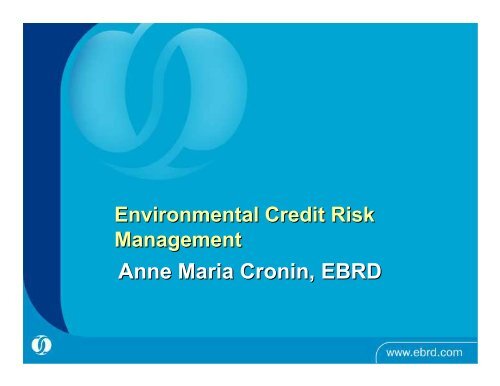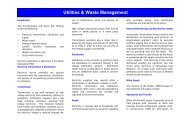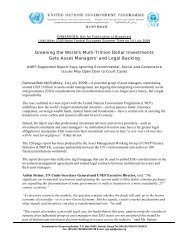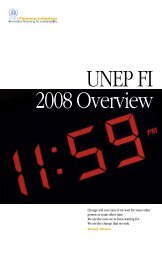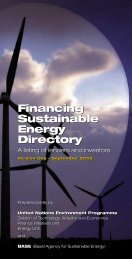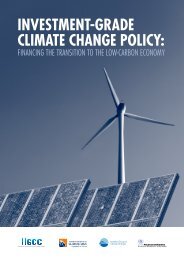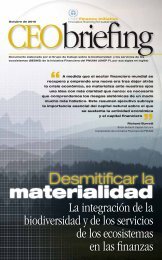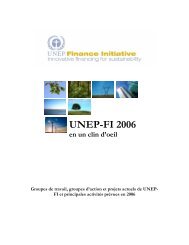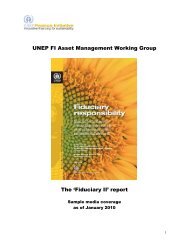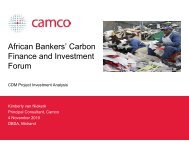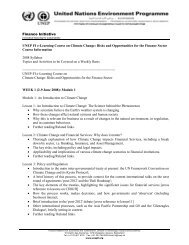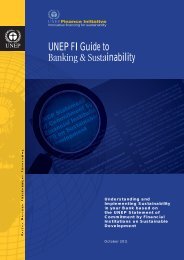Introduction to environmental credit risk management
Introduction to environmental credit risk management
Introduction to environmental credit risk management
You also want an ePaper? Increase the reach of your titles
YUMPU automatically turns print PDFs into web optimized ePapers that Google loves.
Environmental Credit Risk<br />
Management<br />
Anne Maria Cronin, EBRD
What <strong>risk</strong>s do <strong>environmental</strong> issues<br />
create for financial institutions?<br />
Every business activity has some inherent potential <strong>to</strong><br />
cause damage <strong>to</strong> people and property<br />
(<strong>environmental</strong>, health & safety <strong>risk</strong>s)<br />
If clients don’t properly manage those inherent<br />
<strong>environmental</strong> health & safety <strong>risk</strong>s, they can incur<br />
unexpected <strong>environmental</strong>ly derived financial, legal<br />
and reputational liabilities<br />
If you don’t manage the bank’s exposure <strong>to</strong> those<br />
<strong>risk</strong>s and liabilities, they can also become unexpected<br />
financial, legal and reputational <strong>risk</strong>s and liabilities for<br />
the bank.
Environmental Risks for the<br />
Cus<strong>to</strong>mer<br />
<br />
<br />
<br />
<br />
Unexpected <strong>environmental</strong> costs (eg, capital<br />
investments, increased operating costs, fines)<br />
Disruption or cessation of operations<br />
Legal liability for clean-up<br />
Damage <strong>to</strong> their reputation by association<br />
with <strong>environmental</strong>ly controversial activities
Policy<br />
Management<br />
Review<br />
Planning:<br />
• Significant Environmental<br />
Aspects<br />
• Environmental Requirements<br />
• Objectives and Targets<br />
Moni<strong>to</strong>ring:<br />
• Measurement<br />
• Non-conformities<br />
• Records<br />
• Audits<br />
• Reports <strong>to</strong> IFC<br />
Implementation:<br />
• Roles and Responsibilities<br />
• Procedures<br />
• Use of Consultants<br />
• Risk control/supervision<br />
• Training<br />
• Document Control
Core elements <strong>to</strong> manage<br />
<strong>environmental</strong> issues and <strong>risk</strong>s<br />
<br />
High level Policy commitment <strong>to</strong> promote<br />
sustainable development<br />
– Consider HSE issues in its business and<br />
operations in accordance with EMS (eg. in Policy<br />
statement, founding charter, investment policy, by<br />
signing the UNEP Statement).
Structure of the EMS<br />
Policy & Commitment<br />
-Formulate vision & policy<br />
-Define long term objectives<br />
-Communicate vision<br />
-Express commitment<br />
Plan<br />
-Set specific targets<br />
-Select projects & programs<br />
Do<br />
-Execute projects & programs<br />
-Develop and apply procedures<br />
-Provide training<br />
-Adjust organizational structure<br />
Review<br />
-Review EMS & objectives<br />
-Decision on reporting<br />
-Prepare decision making<br />
on expansion EMS<br />
Check<br />
-Moni<strong>to</strong>r progress<br />
-Take corrective measures<br />
-Evaluate EMS; audits
Core Elements – Environmental<br />
Review Procedure<br />
<br />
<br />
Documented<br />
Broken down in<strong>to</strong> key stages:<br />
– screening<br />
– appraisal<br />
– approval<br />
– supervision<br />
<br />
<br />
Integrated with core procedures (<strong>credit</strong> manual, investment<br />
procedure)<br />
Outputs should be documented on sub-project file
Core Elements - ERP<br />
Adoption and Implementation of Environmental Review<br />
Procedure<br />
<br />
Screening:<br />
– this helps determine (1) applicable <strong>environmental</strong> standards (b)<br />
what appraisal action is needed<br />
<br />
Appraisal:<br />
– eg: desk-<strong>to</strong>p review of <strong>environmental</strong> permits; Environmental Audit;<br />
Environmental Impact Assessment<br />
<br />
<br />
Approval - including <strong>environmental</strong> <strong>risk</strong> mitigation if required<br />
Supervision - continued compliance; implementation of agreed<br />
mitigation measures
Core Elements – Contd.<br />
<br />
<br />
<br />
<br />
Appointment of at least one employee <strong>to</strong> conduct, coordinate<br />
<strong>environmental</strong> due diligence on transactions.<br />
Designation of one member of senior <strong>management</strong><br />
with ultimate responsibility for implementation of the<br />
EMS<br />
Setting specific performance indica<strong>to</strong>rs and targets<br />
for the implementation of the FI’s Policy commitment<br />
and review procedures.<br />
Provision of regular training of staff in the application<br />
of the Policy and Procedures
Core Elements - Moni<strong>to</strong>ring<br />
<br />
Regular moni<strong>to</strong>ring and reporting on the<br />
implementation of the EMS, in particular of<br />
key performance areas against targets, in<br />
order <strong>to</strong> advise the Board and stakeholders<br />
where policies and procedures are working<br />
well and where improvements are required.
Core Elements – Objectives and<br />
Targets<br />
<br />
Re-definition of objectives and targets based on<br />
the outcome of moni<strong>to</strong>ring activities.<br />
– Reputational - “we will be the best”<br />
– Operational - “EMS will be implemented in Head<br />
Office by Year 1, major branches by Year 2 and all<br />
branches by Year 3”<br />
– Value-creation - “measured improvement in portfolio<br />
quality due <strong>to</strong> enhanced <strong>risk</strong> <strong>management</strong>”<br />
– Growth - “develop new products such as finance<br />
leasing for <strong>environmental</strong> pollution control technology”
Expanding the scope of the EMS<br />
Integrate sustainability in products and services<br />
<br />
<br />
<br />
include social aspects in loan appraisal process<br />
activities related <strong>to</strong> energy-efficiency and renewable<br />
energy<br />
development and introduction of:<br />
– eco-efficiency or sustainability funds<br />
– new insurance products<br />
– leasing of renewable energy products<br />
– etc,.
Expanding the scope of the EMS<br />
Improve moni<strong>to</strong>ring and EMS efficiency<br />
<br />
<br />
from moni<strong>to</strong>ring progess of individual projects<br />
<strong>to</strong> a set of key performance indica<strong>to</strong>rs<br />
improvement of the efficiency of the EMS as a<br />
whole
Expanding the scope of the EMS<br />
include cost and benefit analysis during review<br />
<br />
<br />
Comprehensive assessment of value added of<br />
environment related activities<br />
Including recommendations on:<br />
– adjustment of vision and policy<br />
– areas <strong>to</strong> be covered by next improvement cycle
Concluding remarks<br />
<br />
The implementation of such a system can yield multiple<br />
benefits:<br />
– <strong>management</strong> of environment related business <strong>risk</strong>s<br />
– new business opportunities (Renewable Energy)<br />
– stronger position of the financial institution as a corporate<br />
citizen and in relation with stakeholders


